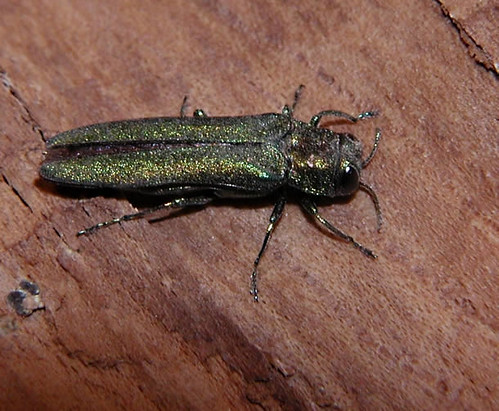
The Emerald Ash Borer (or EAB) has been getting a lot of attention lately, and for good reason. This insect, an invasive species brought from Asia in the infested wood of packing crates, has swept through many states, decimating many varieties of ash tree in its wake. Sometimes this problem is compared to the widespread Dutch Elm disease as it attacked almost 50 years ago, but in fact, it already has the potential to become a much greater issue. Because 1) Emerald Ash Borers kill ash trees completely, 2) EABs can travel long distances between ash trees if necessary, and 3) we have planted ash trees excessively in North America (in part to replace the elm trees lost decades before), America’s ash trees are in trouble.
Because Indian Creek Nature Center receives a lot of phone calls about this insect, this is the first of a three part series meant to set a few things straight about this crawly critter and what can be done about its slow, but inevitable, advance.
First, what exactly is the Emerald Ash Borer? The EAB (referred to in binomial nomenclature as both Agrilus planipennis and Agrilus marcopoli ) is a shiny green beetle that was introduced to the United States in 2002 from Asia (they are found natively in Japan, Korea, some parts of China and even Russia).
Identifying an EAB is a tricky thing as, obviously, not every green beetle you see is an ash borer and, more surprisingly, every ash borer you see is not necessarily an invasive species. Emerald Ash Borers as adults are metallic, green, and approximately 1/2 inch long and 1/8 inch wide. In its larval stage it is harder to identify, but is usually a creamy white color and can grow to be over an inch long.

There are many other species that are easily confused with the EAB, including many indigenous borers that do not damage North American trees to such a devastating extent. The Michigan State University Extension has put together a wonderful printout to show native borers and other relatively harmless insects that can be confused with Emerald Ash Borers. To access the document as a PDF, click here.
As always, you can contact your local extension office if you think that you may have an EAB on your hands. Stay tuned for future entries about identifying trees with EAB infestation symptoms, and more!
(The pictures in this post have been borrowed from EmeraldAshBorer.info and Wikipedia Creative Commons respectively. If borrowed from this entry, please give due credit.)
